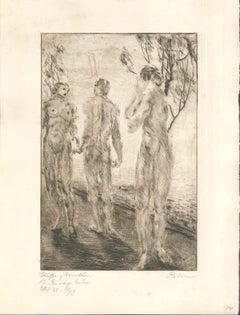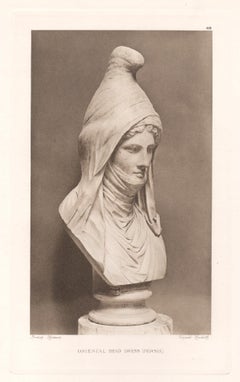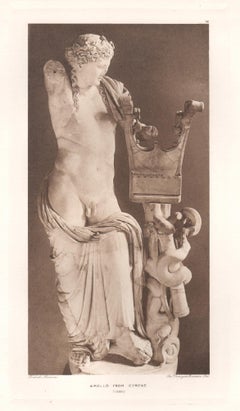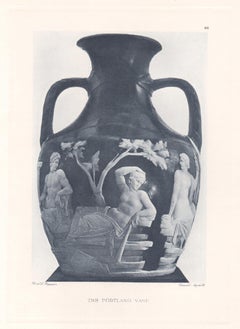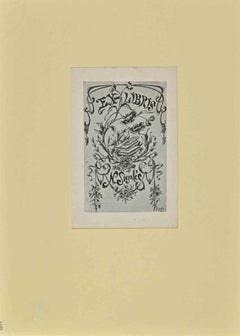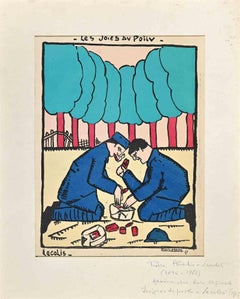1910s Figurative Prints
to
64
390
65
82
13
18
Overall Width
to
Overall Height
to
191
63
24
12
7
1
1
1
1
101
34
22
18
17
3,533
7,600
25,053
6,445
295
599
1,410
1,230
1,260
2,238
3,198
5,156
2,817
1,291
3,031
371
194
2
521
258
239
205
162
123
120
66
64
62
46
42
37
26
22
21
18
17
14
14
198
177
129
114
74
39
192
259
240
Period: 1910s
Mein Weg mit dem Weib #9 - Original Etching by W.R. Rehn
Located in Roma, IT
Drypoint and aquatint (brown ink) on cream paper.
Signed "Rehn" in pencil on the lower right margin and signed on plate "Rehnky" on the lower right margin. Titled and numbered in pe...
Category
Symbolist 1910s Figurative Prints
Materials
Drypoint, Aquatint
Oriental Head Dress (Persia), British Museum Roman antiquity photogravure
Located in Melbourne, Victoria
'Oriental Head Dress (Persia)'
Photogravure after Donald Macbeth (1865-1943).
Donald Macbeth was a commercial photographer who seems to have held a quasi-official position at the B...
Category
Other Art Style 1910s Figurative Prints
Materials
Photogravure
Apollo from Cyrene, British Museum Roman Classical sculpture photogravure
Located in Melbourne, Victoria
'Apollo from Cyrene'
Photogravure from a collection of photogravures depicting Greek and Roman marbles and bronzes in the British museum. Plate number above top right corner of the ...
Category
Other Art Style 1910s Figurative Prints
Materials
Photogravure
The Portland Vase, British Museum Roman antiquity photogravure
Located in Melbourne, Victoria
'The Portland Vase'
Photogravure after Donald Macbeth (1865-1943).
Donald Macbeth was a commercial photographer who seems to have held a quasi-official position at the British Muse...
Category
Other Art Style 1910s Figurative Prints
Materials
Photogravure
Ex Libris - N. Sigale's - Woodcut by José (Josepe) Viola - 1911
Located in Roma, IT
Ex Libris - N. Sigale's is a Modern Artwork realized in 1911 s. by José (Josepe) Viola.
Ex Libris. B/W woodcut on paper.
The work is glued on ivory cardboard. Signed on plate an...
Category
Modern 1910s Figurative Prints
Materials
Woodcut
The Joys of the Hairy - Woodcut Print by Pierre Abadie-Landel - 1917
Located in Roma, IT
The Joys of the Hairy is a woodcut print realized by Pierre Abadie-Landel (1896-1972) in 1917.
This woodcut print is contained in a white passepartout (40x32.5 cm).
Good condition....
Category
Modern 1910s Figurative Prints
Materials
Woodcut
Reims The Cathedral in Flames - Original Lithographby Charles Jouas - 1914
Located in Roma, IT
Reims The Cathedral in Flames is a Lithograph realized by Charles jouas in 1914.
Good condition on a yellowed paper.
Titled and dated on the upper margin, Editor and gallery on the...
Category
Modern 1910s Figurative Prints
Materials
Paper, Lithograph
Le Livre De Ceux Qui Sont Restés - Woodcut by Louis Bouquet - 1916
Located in Roma, IT
Le Livre De Ceux Qui Sont Restés is a booklet of woodcut prints realized by Louis Bouquet in 1916.
Edition" Nouvel Essor" Paris.
Included 9 prints.
Go...
Category
Modern 1910s Figurative Prints
Materials
Woodcut
Military - Original Etching by Anselmo Bucci - 1917
Located in Roma, IT
"Military" is a beautiful print in the etching technique, realized by Anselmo Bucci (1887-1955).
Anselmo Bucci (1887-1955): Italian painter, engraver, and writer, one of the initiat...
Category
Modern 1910s Figurative Prints
Materials
Etching
Ikarus und Daedalus - Etching by Fritz Zalisz - 1914
By Fritz Zalisz
Located in Roma, IT
Ikarus und Daedalus is a beautiful etching and aquatint on ivory-colored paper realized in 1914 by the German expressionist artist, Fritz Zalisz (Gera 1893 - Holzhausen 1971).
Signature and date in pencil on the lower right margin.
In the etching on the lower margin, a long print inscription: "Betet nicht mehr! -Das sollt ihr mir schworen, brigt keine Opfer mehr, das sollt ihr geloben! - Herbert Eulenberg dem Dichter von Ikarus und Daedalus gewidmet. FZ".
This dedicatory inscription refers to the well-known German poet and writer Herbert Eulenberg (1876-1949) who wrote the book "Ikarus und Daedalus. Ein Oratorium", Leipzig 1912.
This original print represents the myth of Icarus and Dedalus with a suggestive symbolist composition, preserved nice impression and is in excellent condition.
Fritz Zalisz (Gera 1893 - Holzhausen 1971).
The German painter, graphic designer and sculptor Fritz Zalisz, considered one of the most important representatives of German expressionism, studied at the Leipzig Academy with Otto Richard Bossert and Alois Kolb...
Category
Symbolist 1910s Figurative Prints
Materials
Etching
BAIGNEUSE ASSISE (D., S. 11)
Located in Aventura, FL
Soft-ground etching, with the stamped signature. From the edition of 1,000. Printed by Ambroise Vollard, 1919, on wove paper, with wide margins. Sheet size: 12.62 x 9.75 in. Image si...
Category
Impressionist 1910s Figurative Prints
Materials
Paper, Etching
$7,125 Sale Price
25% Off
Fruit Sellers - Lithograph by Georges Gobo - 1910s
By Georges Gobo
Located in Roma, IT
Fruit Sellers is a lithograph on ivory-colored paper realized by Georges Gobo.
Signed on the plate.
Good Conditions with slight foxing.
The artwork is created through deft rapid str...
Category
Modern 1910s Figurative Prints
Materials
Lithograph
The Bathers, Woodcut on paper, Signed and dated 1912, Italian Artist
Located in London, GB
Woodcut on paper, signed and dated '1912' bottom right
Image size: 5 x 5 1/4 (12.75 x 13.5 cm)
Mounted
Here the artist's bold gouging of the material has created an evocative scene ...
Category
Italian School 1910s Figurative Prints
Materials
Woodcut
Le Front Italien - Etching on Paper - 1918
Located in Roma, IT
Front Italien is a beautiful print in etching on paper, realized by Anselmo Bucci (1887-1955).
Good conditions.
Sheet dimension: 27.5 x 35.5
From the collection: “Croquis du Front...
Category
Futurist 1910s Figurative Prints
Materials
Etching
Il Supplì - Vintage Art Magazine - 1912
Located in Roma, IT
Il Supplì is an original Modern Artwork realized in 1912 in Italy.
Original print.
Mint conditions.
Il Supplì is a page of an humoristic Italian magazine. This weekly is an anomalous project inspired by two humorous war newspapers: the first La Baracca, produced in a prison camp in Katzenau in 1917 by Italian prisoners of war, the second Dessert by Delfina Metz, designed for the Italian troops involved in the Gulf War.
Category
1910s Figurative Prints
Materials
Offset
1916 German Expressionism Figurative Lithograph Man Two Horses Paul Kleinschmidt
Located in Surfside, FL
Paul Kleinschmidt, (1883–1949)
"Man & Two Horses" Lithograph
1916
Frame: 21" X 17"
Image: 13.5" X 10.5"
Rare Artist's Proof
Provenance: bears labels from ACA Galleries and Richard ...
Category
Abstract 1910s Figurative Prints
Materials
Lithograph
The Painter - Original Woodcut Print by Max Kurzweill - 1916
Located in Roma, IT
The Painter in an original woodcut print realized by Max Kurzweill in 1916.
Good conditions.
The artwork is depicted through harmonious colors in a well-balanced composition.
Category
Modern 1910s Figurative Prints
Materials
Paper, Woodcut
La Loge (The Lodge) /// Post-Impressionist Figurative French Paris People Art
Located in Saint Augustine, FL
Artist: Louis LeGrand (French, 1863-1951)
Title: "La Loge (The Lodge)"
Portfolio: Gazette des Beaux-Arts
*Issued unsigned, though signed by LeGrand in the plat...
Category
Post-Impressionist 1910s Figurative Prints
Materials
Etching, Intaglio, Drypoint
Greco ou le secret de Tolede -Original Woodcut print by Henri Louis Bracons-1918
Located in Roma, IT
Greco ou le secret de Tolede is a woodcut print realized by Henri Louis Bracons
Hand-signed on the lower right in pencil. Numbered on the lower left, the edition of 27/50 prints. Pa...
Category
Modern 1910s Figurative Prints
Materials
Woodcut
In Versum Distulit Ulmos - Original Etching by Dunoyer de Segonzac - 1944/47
Located in Roma, IT
Hand signed. Edition of 200 copies.
This beautiful etching belongs to the series of illustrations that the French artist André Dunoyer de Segonzac realized for the "Georgics" by the...
Category
Modern 1910s Figurative Prints
Materials
Drypoint, Etching
The Old Teacher of Philosophy - Original Drypoint by Jeanne Bardey - 1913
Located in Roma, IT
The Old Teacher of Philosophy is an original artwork realized by French Artist Jeanne Bardey (1872 - 1954)
Drypoint print. Hand-signed on the lower right in pencil, on up dated 191...
Category
Modern 1910s Figurative Prints
Materials
Drypoint
Militant - Original Etching by Anselmo Bucci - 1917
Located in Roma, IT
"Military" 1917 is a beautiful print in etching technique, realized by Anselmo Bucci (1887-1955).
Hand signed. Numbered 89/100 of prints on the lower left. On the lower left corner,...
Category
Modern 1910s Figurative Prints
Materials
Etching
Kriegsnotspende für Leipzig - Etching by Bruno Héroux - 1916
By Bruno Héroux
Located in Roma, IT
Kriegsnotspende für Leipzig is an amazing black and white etching on paper, realized in 1909 by the German painter, Bruno Héroux (Leipzig, 1868-1944). Sig...
Category
Symbolist 1910s Figurative Prints
Materials
Lithograph
Loden Dal Brun - Vintage Advertising Lithograph by Achille Beltrame - 1910 ca.
Located in Roma, IT
Loden Dal Brun is a beautiful and rare color lithograph printed by G. Ricordi and C. Milano, Milan between 1895 and 1914.
A vintage poster representing an elegant couple walking, wi...
Category
Art Nouveau 1910s Figurative Prints
Materials
Lithograph
Krieg (War) - Original Woodcut by Hans Trudel - 1915
Located in Roma, IT
Krieg ("War") is an original artwork realized by Hans Trudel in 1915. The monogram of the artist appears on the lower right margin. The xilograph is part of a portfolio including fiv...
Category
1910s Figurative Prints
Materials
Woodcut
Soldier at the Front - Original Etching by Anselmo Bucci - 1910s
Located in Roma, IT
Soldier at the Front is an original etching realized by Anselmo Bucci in 1917.
Limited edition of 200 copies.
The artwork represent a soldier at the front during the WWI 1915/1918....
Category
Modern 1910s Figurative Prints
Materials
Etching
President's Wilson Great Message - Vintage Poster - 1917
Located in Roma, IT
President's Wilson Great Message is an original vintage poster, realized n 1917.
The status of preservation is quite Good.
Category
Modern 1910s Figurative Prints
Materials
Photogravure
Stage - Original Woodcut by Moses Levy - 1914
Located in Roma, IT
Stage is an original woodcut print realized by Moses Levi in 1914.
The state of preservation of the artwork is very good.
Passepartout dimension: 52.5 x 37 cm.
Category
1910s Figurative Prints
Materials
Woodcut
War Bulletin - Vintage Photlithograph on Cardboard - 1918
Located in Roma, IT
War Bulletin is an vintage photolithograph on cardboard realized by Anonymous Artist of the 20th Century as War Bulletin of the 1st World War.
The state of preservation of the art...
Category
1910s Figurative Prints
Materials
Photogravure
Oli Sasso - Original Advertising Lithograph by Plinio Nomellini - 1914 ca.
Located in Roma, IT
Oli Sasso is a colored lithographed original manifesto on cardboard, realized around 1914 by the Italian artist Plinio Nomellini.
This modern artwork is signed on plate on higher left margin and has the inscriptions printed on lower margin in the image "Chiedere Catalogo e Campioni ai Sigg. Sasso Oneglia e Figli", under the image: "P. Nomellini/ Off. G. Ricordi and C. Milano / 140 x 200". From the Ricordi Portfolio...
Category
1910s Figurative Prints
Materials
Lithograph
Beggars - Original Photolithograph on Creamy Paper - 1910
Located in Roma, IT
Beggars is an original Modern artwork realized by Albert Maria Roussel (1869 – 1937) in 1910.
Original phototype on Creamy paper.
Signed and dated by the artist on plate the lowe...
Category
1910s Figurative Prints
Materials
Lithograph
Militant - Original Etching by Anselmo Bucci - 1914
Located in Roma, IT
"Military" 1914 is a beautiful print in etching technique, realized by Anselmo Bucci (1887-1955).
Hand signed. Numbered 89/100 of prints on the lower left. On the lower left corner,...
Category
Modern 1910s Figurative Prints
Materials
Etching
Military - Original Etching by Anselmo Bucci - 1917
Located in Roma, IT
"Military" 1917s is a beautiful print in etching technique, realized by Anselmo Bucci (1887-1955).
Hand signed. Numbered 61/100 of prints on the lower left. On the lower left corner...
Category
Modern 1910s Figurative Prints
Materials
Etching
Militant - Etching by Anselmo Bucci - 1917
Located in Roma, IT
"Military" 1917s is a beautiful print in etching technique, realized by Anselmo Bucci (1887-1955).
Hand signed. Numbered 61/100 of prints on the lower left. On the lower left corner...
Category
Modern 1910s Figurative Prints
Materials
Etching, Drypoint
Military - Etching by Anselmo Bucci - 1917
Located in Roma, IT
"Military" 1917s is a beautiful print in etching technique, realized by Anselmo Bucci (1887-1955).
Hand signed. Numbered 61/100 of prints on the lower left. On the lower left corner...
Category
Modern 1910s Figurative Prints
Materials
Etching
Militaries - Lithograph on Paper - 1918
Located in Roma, IT
Militaries is an original lithograph by the Italian artist, painter, and printmaker Anselmo Bucci.
Signed on the plate on the lower left.
In very good conditions.
The artwork repr...
Category
1910s Figurative Prints
Materials
Lithograph
La Couvèe de L’eau - Original Etching by Anselmo Bucci - 1917
Located in Roma, IT
Image dimensions: 11 x 8.5 cm.
Hand signed. Edition of 100 prints on Hollande paper. From the collection: “Croquis du Front Italien” , published in Paris by D'Alignan editions. Anse...
Category
Futurist 1910s Figurative Prints
Materials
Drypoint, Etching
Militant - Etching by Anselmo Bucci - 1917
Located in Roma, IT
"Military" 1917s is a beautiful print in etching technique, realized by Anselmo Bucci (1887-1955).
Hand signed. Numbered 61/100 of prints on the lower left. On the lower left corner...
Category
Modern 1910s Figurative Prints
Materials
Etching, Drypoint
Military - Original Etching by Anselmo Bucci - 1910s
Located in Roma, IT
"Military" is a beautiful print in the etching technique, realized by Anselmo Bucci (1887-1955) in 1910s.
In good conditions.
The artwork represents the war scenery and an only per...
Category
Modern 1910s Figurative Prints
Materials
Etching
La Nuit Venitienne, Fantasio, Les Caprices de Marianne
Located in Wilton, CT
Brunellechi's classic color drawings elegantly illustrate three plays by Musset, "La Nuit Venitienne", "Fantasio", and "Les Caprices de Marianne"
Category
1910s Figurative Prints
Materials
Paper, Aquatint
$640 Sale Price
20% Off
Front Italien - Etching on Paper - 1918
Located in Roma, IT
Front Italien is a beautiful print in etching on paper, realized by Anselmo Bucci (1887-1955).
Good conditions except for some diffused foxings.
Sheet dimension: 36 x 27.5
From t...
Category
Futurist 1910s Figurative Prints
Materials
Etching
Soldier at the Front - Original Etching by Anselmo Bucci - 1917
Located in Roma, IT
Soldier at the Front is an original etching realized by Anselmo Bucci in 1917.
Limited edition of 200 copies.
The artwork represent a soldier at the front during the 1 war 1915/191...
Category
Modern 1910s Figurative Prints
Materials
Etching
Military - Original Etching by Anselmo Bucci - 1917s
Located in Roma, IT
"Military" 1917s is a beautiful print in etching technique, realized by Anselmo Bucci (1887-1955).
Hand signed. Numbered 61/100 of prints on the lower left. On the lower left corner...
Category
Modern 1910s Figurative Prints
Materials
Etching
Front Italien - Etching on Paper - 1918
Located in Roma, IT
Front Italien is a beautiful print in etching on paper, realized by Anselmo Bucci (1887-1955).
Good conditions.
Sheet dimension: 27.5 x 35.5
From the collection: “Croquis du Fron...
Category
Futurist 1910s Figurative Prints
Materials
Etching
Extenués - Etching by Anselmo Bucci - 1917
Located in Roma, IT
Image dimensions: 6 x 8 cm.
Hand signed. Edition of 100 prints on Hollande paper. From the collection: “Croquis du Front Italien” , published in Paris by D'Alignan editions. Anselmo...
Category
Futurist 1910s Figurative Prints
Materials
Drypoint, Etching
Military - Etching by Anselmo Bucci - 1917
Located in Roma, IT
"Military" 1917s is a beautiful print in etching technique, realized by Anselmo Bucci (1887-1955).
Hand signed. Numbered 89/100 of prints on the lower left. On the lower left corner...
Category
Modern 1910s Figurative Prints
Materials
Etching
Pula 1918 - Lithograph on Paper - 1918
Located in Roma, IT
Pula 1918 is an original lithograph by the Italian artist, painter, and printmaker Anselmo Bucci.
Signed on the plate on the lower right.
In very good conditions.
The artwork repr...
Category
1910s Figurative Prints
Materials
Lithograph
Military - Original Etching by Anselmo Bucci - 1917
Located in Roma, IT
"Military" 1917s is a beautiful print in etching technique, realized by Anselmo Bucci (1887-1955).
Hand signed. Numbered 61/100 of prints on the lower left. On the lower left corner...
Category
Modern 1910s Figurative Prints
Materials
Etching
Military - Original Etching by Anselmo Bucci - 1917
Located in Roma, IT
"Military" 1917s is a beautiful print in etching technique, realized by Anselmo Bucci (1887-1955).
Hand signed. Numbered 23/100 of prints on the lower left. On the lower left corner...
Category
Modern 1910s Figurative Prints
Materials
Etching
The War - Lithograph by Anselmo Bucci - 1918
Located in Roma, IT
The war is an original lithograph on ivory paper, signed on the plate on the lower right and date by the Italian artist, painter, and printmaker Anselmo Bucci.
In very good conditio...
Category
Futurist 1910s Figurative Prints
Materials
Lithograph
Military - Etching by Anselmo Bucci - 1917
Located in Roma, IT
"Military" 1917s is a beautiful print in etching technique, realized by Anselmo Bucci (1887-1955).
Hand signed. Numbered 61/100 of prints on the lower left. On the lower left corner...
Category
Modern 1910s Figurative Prints
Materials
Etching
Militant - Etching by Anselmo Bucci - 1917s
Located in Roma, IT
"Military" 1917s is a beautiful print in etching technique, realized by Anselmo Bucci (1887-1955).
Hand signed. Numbered 61/100 of prints on the lower left. On the lower left corner...
Category
Modern 1910s Figurative Prints
Materials
Etching
La Paye - Original Etching by Anselmo Bucci - 1917
Located in Roma, IT
Image dimensions: 15.5 x 23 cm.
Hand signed. Edition of 100 prints on Hollande paper. From the collection: “Croquis du Front Italien”, published in Paris by D'Alignan editions. Anse...
Category
Futurist 1910s Figurative Prints
Materials
Drypoint, Etching
Military - Original Etching by Anselmo Bucci - 1917
Located in Roma, IT
"Military" 1917s is a beautiful print in etching technique, realized by Anselmo Bucci (1887-1955).
Hand signed. Numbered 23/100 of prints on the lower left. On the lower left corner...
Category
Modern 1910s Figurative Prints
Materials
Etching
Military - Original Etching by Anselmo Bucci - 1917
Located in Roma, IT
"Military" 1917s is a beautiful print in etching technique, realized by Anselmo Bucci (1887-1955).
Hand signed. Numbered 61/100 of prints on the lower left. On the lower left corner...
Category
Modern 1910s Figurative Prints
Materials
Etching
Militant - Original Etching by Anselmo Bucci - 1917
Located in Roma, IT
"Military" 1917 is a beautiful print in etching technique, realized by Anselmo Bucci (1887-1955).
Hand signed. Numbered 89/100 of prints on the lower left. On the lower left corner,...
Category
Modern 1910s Figurative Prints
Materials
Etching
Militant - Original Etching by Anselmo Bucci - 1917
Located in Roma, IT
"Military" 1917 is a beautiful print in etching technique, realized by Anselmo Bucci (1887-1955).
Hand signed. Numbered 61/100 of prints on the lower left. On the lower left corner,...
Category
Modern 1910s Figurative Prints
Materials
Etching
Military - Original Etching by Anselmo Bucci - 1917s
Located in Roma, IT
"Military" 1917s is a beautiful print in etching technique, realized by Anselmo Bucci (1887-1955).
Hand signed. Numbered 61/100 of prints on the lower left. On the lower left corner...
Category
Modern 1910s Figurative Prints
Materials
Etching
Military - Original Etching by Anselmo Bucci - 1917
Located in Roma, IT
"Military" 1917s is a beautiful print in etching technique, realized by Anselmo Bucci (1887-1955).
Hand signed. Numbered 23/100 of prints on the lower left. On the lower left corner...
Category
Modern 1910s Figurative Prints
Materials
Etching
Military - Etching by Anselmo Bucci - 1917
Located in Roma, IT
"Military" 1917s is a beautiful print in etching technique, realized by Anselmo Bucci (1887-1955).
Hand signed. Numbered 81/100 of prints on the lower left. On the lower left corner...
Category
Modern 1910s Figurative Prints
Materials
Etching
Recently Viewed
View AllMore Ways To Browse
Kim Tschang Yeul
Tom Blackwell On Sale
Tom Everhart Lithograph
Torii Kotondo
Victor Richardson
Vintage Boulangerie Signs
Vintage Les Nereides
Vintage Meat Scales
Vintage Multiplier Reel
Warhol Northwest Mask
Whistler Fumette
Yoko Ono Lithograph Harold Town
Zeno Giglietti
Ak47 Lotus
Alex Katz Bicycle
Alex Katz Christy
Alex Katz Twilight
Alex Katz Wedding Dress
